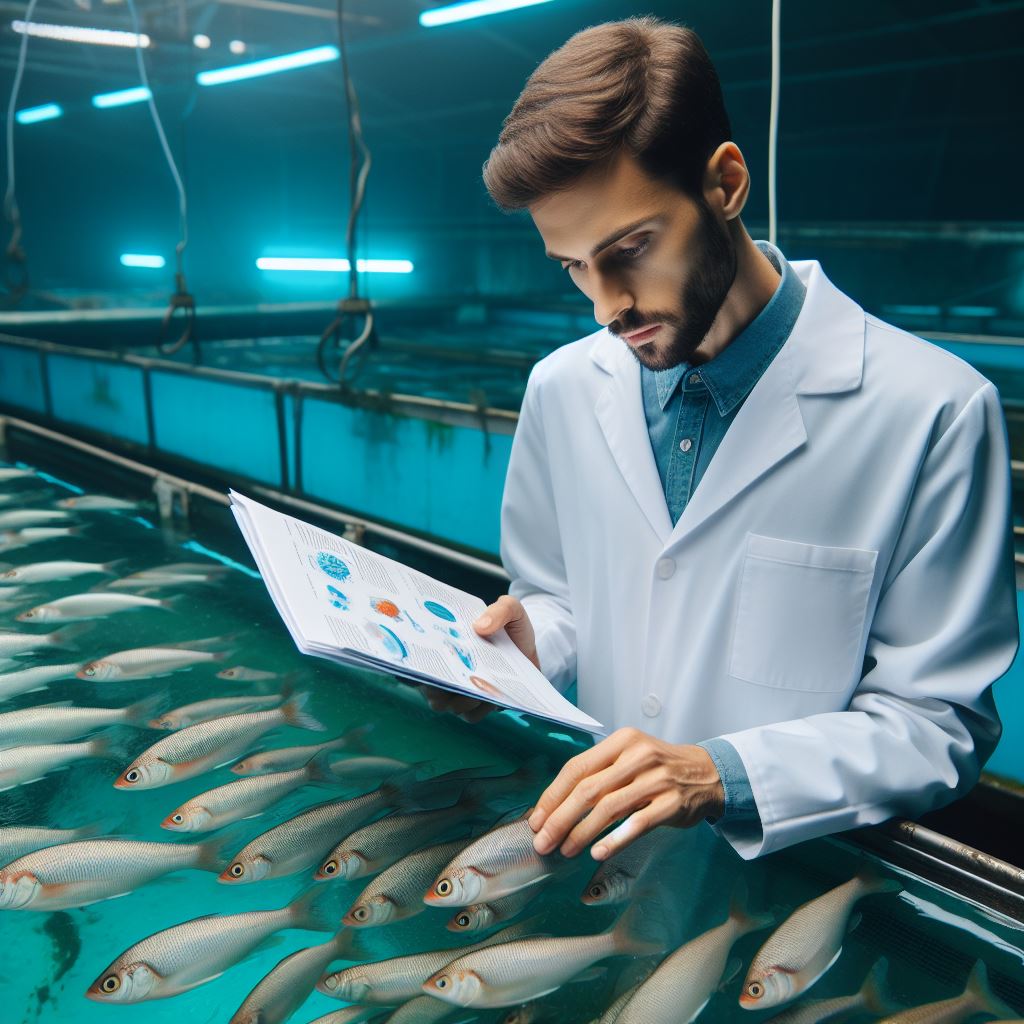Aquaculture Genetics: Better Fish Breeding
Last Updated on March 2, 2024
Introduction
Aquaculture genetics plays a crucial role in improving fish breeding practices, both economically and environmentally.
In this section, we will provide a brief overview of the topic, highlighting its significance.
Aquaculture employs selective breeding techniques to enhance desirable traits in fish populations.
These traits can include growth rate, disease resistance, and feed conversion efficiency.
By focusing on these attributes, aquaculturists can produce higher quality fish that are more productive and resilient.
This not only benefits the aquaculture industry economically but also helps reduce pressure on wild fish populations.
Moreover, through the utilization of advanced genetic technologies, such as CRISPR-Cas9, scientists are able to accelerate the breeding process and introduce desired characteristics more efficiently.
By understanding the genetic makeup of fish, researchers and breeders can selectively breed fish with desirable traits, improving their overall performance in various farming systems.
Therefore, aquaculture genetics is instrumental in the development and advancement of fish breeding techniques, resulting in improved productivity, sustainability, and profitability.
Understanding Aquaculture Genetics
Definition and explanation
Aquaculture genetics refers to the study of genetic principles and techniques applied in the breeding of fish and other aquatic organisms.
It involves understanding the genetic makeup of these organisms to enhance desirable traits through selective breeding.
Genetic principles in aquaculture aim to improve the overall performance and quality of farmed fish.
By selectively breeding individuals with desirable characteristics such as fast growth, disease resistance, and better feed conversion, the aquaculture industry can produce fish with improved traits.
Role of genetics in aquaculture
Genetics plays a crucial role in aquaculture by providing the knowledge and tools necessary to produce high-quality fish stocks.
It helps in identifying favorable genetic traits and understanding the genetic variations among different populations.
By studying the genetic variations, scientists can select parent fish with complementary traits, leading to improved offspring.
This process, known as selective breeding, helps in the development of genetically superior fish populations over time.
Genetics also helps in identifying and managing genetic diseases and abnormalities in aquaculture.
By understanding the genetic basis of these conditions, breeders can implement strategies to prevent, control, or eliminate such issues from their fish stocks.
Significance of selective breeding in aquaculture
Selective breeding is a key technique used in aquaculture to enhance the desired traits in fish populations.
This process involves carefully selecting the parent fish based on their genetic makeup and performance.
Through selective breeding, aquaculturists can produce fish with improved growth rates, disease resistance, and tolerance to environmental stressors.
This leads to higher production efficiency, reduced mortality, and overall improved profitability.
Selective breeding also helps in conserving and preserving valuable genetic resources.
By identifying and maintaining genetically diverse populations, aquaculture can safeguard against the loss of genetic traits and adaptability in fish populations.
Moreover, selective breeding contributes to sustainable development in aquaculture.
By focusing on traits like feed efficiency and disease resistance, breeders can reduce the environmental impact of fish farming, improve resource utilization, and minimize the use of antibiotics and chemicals.
Lastly, aquaculture genetics is a vital field that contributes to the development and improvement of fish farming.
Through the understanding of genetic principles, selective breeding, and the use of genetic tools, aquaculture can produce fish with superior traits, enhance disease resistance, ensure sustainability, and maximize economic returns.
Read: Beef Cattle Genetics: Traits for Better Beef
Genetic Techniques in Aquaculture
Aquaculture, the farming of aquatic organisms, including fish, has gained significant importance in meeting the increasing global demand for seafood.
To ensure sustainable aquaculture practices, genetic techniques play a crucial role in improving fish breeding and enhancing desirable traits in farmed species.
Traditional breeding methods
- Natural mating: One of the oldest and simplest methods, allowing fish to breed naturally in controlled environments. By selecting parent fish with desirable traits, breeders can pass on these traits to their offspring, creating improved genetic lines.
- Selecting favorable traits: Breeders carefully choose fish with specific desirable characteristics, such as fast growth, disease resistance, or tolerance to environmental factors. This process involves selective breeding over multiple generations to strengthen and perpetuate these valuable traits.
Modern genetic technologies
- Genetic markers and mapping: DNA markers are used to identify and locate genes associated with desired traits. By analyzing the genetic composition of fish, breeders can selectively breed individuals with the desired genetic makeup for enhanced traits.
- Gene editing and transgenesis: Advanced genetic modification techniques, like gene editing using CRISPR, enable precise modifications of fish genomes. This technology allows for the deletion, insertion, or modification of specific genes, leading to the development of improved breeds with desirable characteristics.
- Use of assisted reproductive technologies: Assisted reproductive techniques help enhance breeding efficiency and overcome natural limitations. Artificial insemination enables breeders to control genetic combinations and increase breeding rates. In vitro fertilization allows for the manipulation of DNA before fertilization, leading to the production of offspring with desired traits.
The use of modern genetic technologies in aquaculture does raise concerns regarding ethical, legal, and environmental implications.
Careful consideration must be given to potential risks associated with gene editing and genetically modified organisms, including potential unintended consequences on wild populations or ecosystem balance.
Proper regulations and oversight should be in place to ensure responsible and sustainable implementation of these techniques.
Most importantly, genetic techniques play a crucial role in improving the breeding of fish in aquaculture.
Traditional breeding methods, such as natural mating and selecting favorable traits, have been practiced for centuries.
However, modern genetic technologies, including genetic markers and mapping, gene editing and transgenesis, and assisted reproductive technologies, offer more precise and efficient means of enhancing desired traits in farmed fish species.
By responsibly and ethically employing these tools, aquaculture can contribute to meeting the growing demand for seafood in a sustainable manner.
Read: The Importance of Biosecurity in Poultry Farms
Benefits of Aquaculture Genetics
Improved fish health and disease resistance
Through the application of aquaculture genetics, fish can be selectively bred to possess stronger immune systems, reducing the incidence of diseases.
Improved fish health and disease resistance is one of the key benefits of aquaculture genetics.
By selectively breeding fish with naturally stronger immune systems, farmers can reduce the risk of disease outbreaks and improve overall fish health.
This not only ensures higher survival rates but also minimizes the need for antibiotics and other treatments, making the aquaculture industry more sustainable.
Enhanced growth rates and productivity
By genetically selecting individuals with superior growth characteristics, aquaculture can maximize the growth rates and improve production efficiency.
In addition to improved health, aquaculture genetics also offers enhanced growth rates and productivity.
By selectively breeding fish that exhibit faster growth, farmers can increase their yield and reduce the time required to bring fish to market size.
This not only increases profitability but also meets the ever-growing demand for seafood in a more efficient manner.
Better quality and profitability in aquaculture products
Aquaculture genetics allow for the production of fish with desirable traits such as better taste, texture, and appearance, resulting in higher profits for farmers.
Aquaculture genetics also contributes to better quality and profitability in aquaculture products.
Through careful genetic selection, farmers can produce fish with desired traits such as superior taste, texture, color, and size.
This quality improvement helps to meet consumer preferences and increases market value, resulting in higher profits for farmers.
Conservation of endangered fish species
Aquaculture genetics plays a crucial role in conserving endangered fish species by maintaining their populations through controlled breeding programs.
Furthermore, aquaculture genetics plays a crucial role in conserving endangered fish species.
By implementing controlled breeding programs, scientists and conservationists can prevent the irreversible loss of endangered fish species.
These programs allow for the maintenance of genetic diversity and the preservation of unique species, ensuring their survival for future generations.
Overall, aquaculture genetics provides numerous benefits to the aquaculture industry and the environment.
The ability to selectively breed fish with improved health, enhanced growth rates, and better quality leads to increased profitability for farmers while meeting consumer demands.
Additionally, by conserving endangered fish species, aquaculture genetics plays a vital role in protecting biodiversity and maintaining ecological balance.
It is evident that the continued advancement of aquaculture genetics is essential for the sustainable growth and development of the aquaculture industry.
Read: Poultry Behavior: Understanding Your Flock

Challenges and Ethical Considerations
Potential risks of genetic modifications
Aquaculture genetics presents various challenges and ethical considerations that need careful examination.
One significant concern is the potential risks associated with genetic modifications.
Genetic modifications can reduce genetic diversity, increasing the vulnerability of fish to diseases.
Additionally, there is a risk of unintended effects on ecosystems if genetically modified fish escape into the wild.
This could lead to negative impacts on natural populations through interbreeding or competition.
Furthermore, the long-term effects on the overall health and welfare of genetically modified fish remain unknown.
It is crucial to ensure the safety and well-being of these organisms before widespread implementation.
Consumer acceptance and market demand are additional factors to consider.
Some individuals may have reservations about consuming genetically modified fish products, leading to reduced market demand.
Ethical concerns regarding genetically modified fish
Ethical concerns also surround genetically modified fish.
Animal welfare is at the forefront, as genetic modifications may potentially cause harm or suffering.
Interfering with natural genetic processes and creating artificial organisms raise moral considerations.
Furthermore, altering the natural genetic makeup of aquaculture species can have unintended consequences, affecting ecological balance and biodiversity.
Ownership and control of genetically modified fish and their genetic traits pose ethical questions.
Determining who owns the technology and who controls the distribution and commercialization of genetically modified fish is crucial.
Additionally, ensuring equitable access to genetic modification technology among different regions and socioeconomic groups is essential to prevent potential disparities.
Regulation and policies in aquaculture genetics
Developing robust regulations and policies is key to addressing these challenges and ethical concerns.
Regulatory frameworks should be established to assess and monitor genetically modified fish.
This includes implementing strict labeling requirements to inform consumers about genetically modified fish products.
Ethical guidelines and standards should be enforced to ensure responsible research and commercialization practices.
Collaboration between governments, scientists, and stakeholders is necessary to develop internationally harmonized regulations in aquaculture genetics.
Transparency and public participation in decision-making processes are vital to ensure a balanced approach and address societal concerns.
Ultimately, while aquaculture genetics offers potential benefits, it also presents challenges and ethical considerations.
Understanding and addressing the potential risks, ethical concerns, and implementing effective regulation are crucial for the responsible development and use of genetically modified fish in aquaculture.
It is essential to strike a balance between scientific advancements and ethical considerations to ensure the sustainable and responsible future of aquaculture genetics.
Read: Top Breeds for Profitable Pig Farming
Success Stories in Aquaculture Genetics
Case studies of successful fish breeding programs
The selective breeding program of Atlantic salmon in Norway has significantly improved growth rates and disease resistance.
Tilapia breeding programs in Egypt have led to increased production and improved traits such as size, growth, and disease resistance.
In China, the selective breeding program for grass carp resulted in fast-growing and disease-resistant strains.
The breeding program for Nile tilapia in the Philippines has produced strains with high growth rates and tolerance to low oxygen levels.
Successful breeding programs for Pacific white shrimp in Ecuador have increased production and improved disease resistance.
Impact on global fisheries and food security
Aquaculture genetics plays a vital role in meeting the growing global demand for fish and seafood.
By selectively breeding fish with desirable traits, aquaculture genetics improves production efficiency and reduces pressure on wild fish stocks.
Successful fish breeding programs contribute to food security by increasing the availability of affordable and nutritious protein sources.
Aquaculture genetics also helps in the diversification of fish species, reducing dependence on a limited number of commercially cultivated species.
Improved disease resistance through breeding programs reduces the risk of outbreaks, preventing economic losses and ensuring a stable food supply.
The commercial success of fish breeding programs stimulates economic growth in the aquaculture sector and creates employment opportunities.
Aquaculture genetics promotes sustainable practices, as it enables the production of fish with better feed conversion rates and reduced environmental impact.
By improving the productivity and profitability of fish farms, aquaculture genetics contributes to poverty alleviation and rural development.
The availability of genetically improved fish strains enhances the resilience of fish farming systems to climate change and natural disasters.
Aquaculture genetics also plays a significant role in the conservation and restoration of endangered fish species through captive breeding programs.
Overall, the success stories in aquaculture genetics demonstrate the potential of selective breeding to produce fish with improved traits and contribute to global fisheries and food security.
These programs not only enhance productivity and profitability but also promote sustainable practices and conservation efforts.
Through continued research and development, aquaculture genetics will play an increasingly important role in meeting the world’s growing demand for fish and seafood while minimizing strain on natural resources.
Delve into the Subject: Solar Power in Livestock Farming: A Guide
Future Directions in Aquaculture Genetics
Aquaculture genetics is a rapidly evolving field with immense potential for improving fish breeding.
In this section, we will explore the emerging genetic technologies, the role of genomics and bioinformatics, and promising areas of research and development in the field.
Emerging genetic technologies and their potential
- Gene editing techniques like CRISPR-Cas9 offer precise modifications to fish genomes.
- Marker-assisted selection helps in identifying desirable traits and accelerating breeding programs.
- Genomic selection allows for predicting breeding values based on DNA markers and phenotypic data.
- Hybridization and polyploidy induction can lead to hybrid vigor and improved growth rates.
- Cryopreservation of fish embryos and sperm enables preservation of valuable genetic resources.
- Cloning and nuclear transfer methods can be used for reproduction of elite individuals.
Role of genomics and bioinformatics in fish breeding
- Genomics provides valuable insights into the genetic basis of traits and their heritability.
- High-throughput sequencing technologies allow for efficient identification of genes and genetic variations.
- Bioinformatics tools aid in data analysis, genome annotation, and understanding complex genetic interactions.
- Comparative genomics helps in studying evolutionary relationships and identifying genes of interest.
- Genomic selection models incorporate genomic information for accurate prediction of breeding values.
Promising areas of research and development
- Improving disease resistance through selective breeding and vaccination strategies.
- Enhancing feed conversion efficiency and reducing environmental impacts of aquaculture.
- Exploring the potential of epigenetics in influencing fish phenotypic traits.
- Investigating genetic basis of stress tolerance and developing stress-resistant fish strains.
- Understanding the interactions between genetics, nutrition, and environmental factors for optimal growth.
- Studying the impact of climate change on fish genetics and developing resilient strains.
- Incorporating social, economic, and ethical considerations in aquaculture breeding programs.
All in all, the future of aquaculture genetics holds tremendous potential.
Emerging genetic technologies, along with the integration of genomics and bioinformatics, offer new avenues for improving fish breeding.
Promising areas of research and development aim to enhance various aspects of aquaculture, from disease resistance to environmental sustainability.
By harnessing the power of genetics, we can shape the future of fish breeding and contribute to the sustainable growth of the aquaculture industry.
Conclusion
In this section, we have discussed the importance of aquaculture genetics in improving fish breeding.
We have seen the potential benefits that can be achieved through the development of better breeding techniques.
It is clear that investment in aquaculture genetics is crucial for the future of sustainable fish farming.
By exploring and investing in this field, we can ensure the production of healthier and more resilient fish populations.
The advancements in aquaculture genetics can also lead to increased profitability for fish farmers.
Therefore, it is vital for governments, research institutions, and industry stakeholders to support and promote further exploration in this area.
Through collaborative efforts, we can enhance fish breeding practices and contribute to food security and environmental sustainability.
It is undeniable that aquaculture genetics holds great promise for the future of fish farming.
By harnessing the power of genetics, we can address the challenges of food production in a rapidly growing global population.
To maximize the potential of aquaculture genetics, continued research, innovation, and financial support are necessary.
The time for action is now – let us come together to unlock the full potential of aquaculture genetics.


